2014 MERCEDES-BENZ S-Class Air matic
[x] Cancel search: Air maticPage 162 of 434
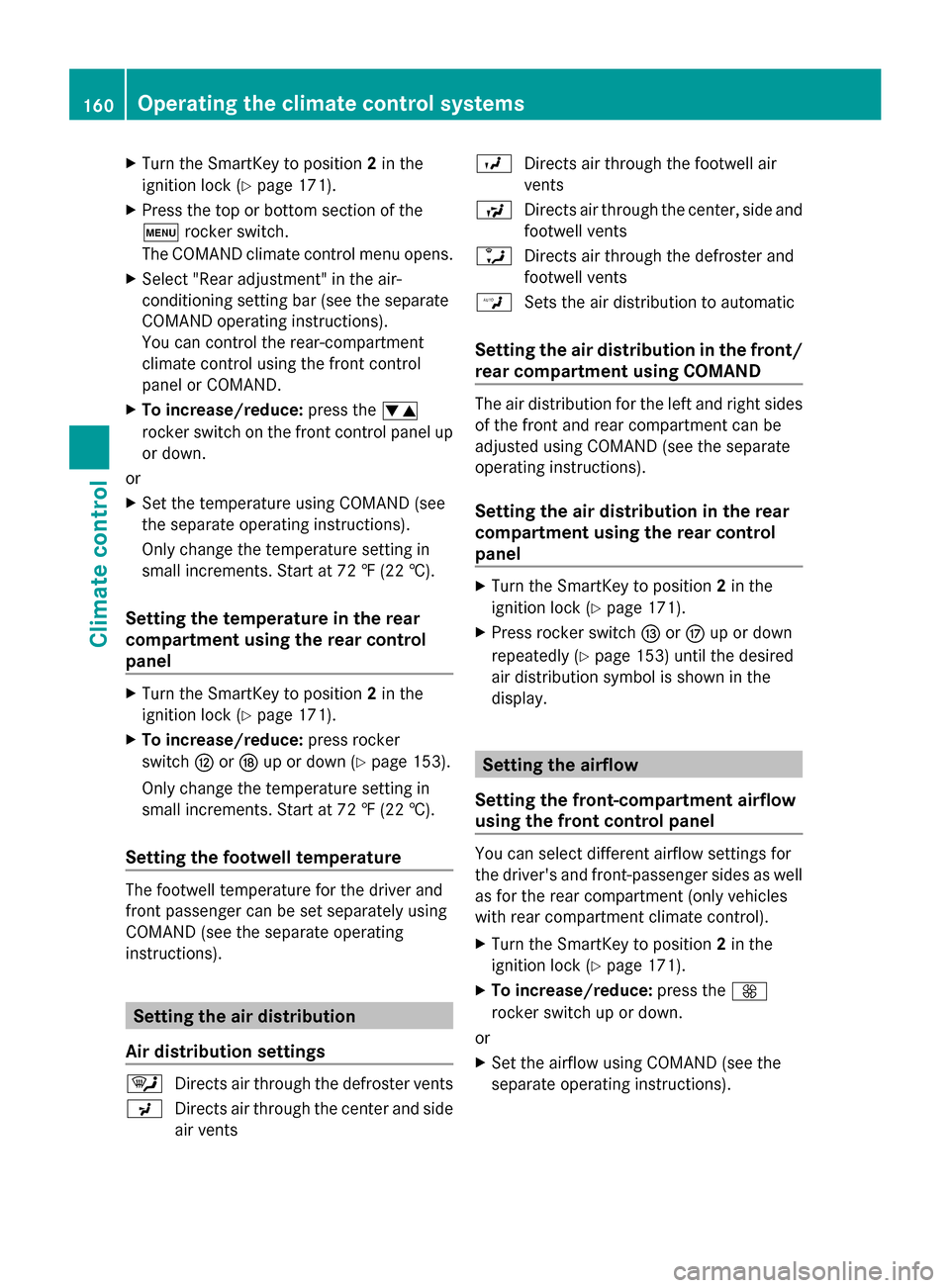
X
Turn the SmartKey to position 2in the
ignition lock (Y page 171).
X Press the top or bottom section of the
008A rocker switch.
The COMAND climate control menu opens.
X Select "Rear adjustment" in the air-
conditioning setting bar (see the separate
COMAND operating instructions).
You can control the rear-compartment
climate control using the front control
panel or COMAND.
X To increase/reduce: press the0082
rocker switch on the front control panel up
or down.
or
X Set the temperature using COMAND (see
the separate operating instructions).
Only change the temperature setting in
small increments. Start at 72 ‡ (22 †).
Setting the temperature in the rear
compartment using the rear control
panel X
Turn the SmartKey to position 2in the
ignition lock (Y page 171).
X To increase/reduce: press rocker
switch 0070or0076 up or down (Y page 153).
Only change the temperature setting in
small increments. Start at 72 ‡ (22 †).
Setting the footwell temperature The footwell temperature for the driver and
front passenger can be set separately using
COMAND (see the separate operating
instructions). Setting the air distribution
Air distribution settings 0061
Directs air through the defroster vents
009C Directs air through the center and side
air vents 009B
Directs air through the footwell air
vents
009F Directs air through the center, side and
footwell vents
0086 Directs air through the defroster and
footwell vents
00A2 Sets the air distribution to automatic
Setting the air distribution in the front/
rear compartment using COMAND The air distribution for the left and right sides
of the front and rear compartment can be
adjusted using COMAND (see the separate
operating instructions).
Setting the air distribution in the rear
compartment using the rear control
panel X
Turn the SmartKey to position 2in the
ignition lock (Y page 171).
X Press rocker switch 0071or0075 up or down
repeatedly (Y page 153) until the desired
air distribution symbol is shown in the
display. Setting the airflow
Setting the front-compartment airflow
using the front control panel You can select different airflow settings for
the driver's and front-passenger sides as well
as for the rear compartment (only vehicles
with rear compartment climate control).
X
Turn the SmartKey to position 2in the
ignition lock (Y page 171).
X To increase/reduce: press the0097
rocker switch up or down.
or
X Set the airflow using COMAND (see the
separate operating instructions). 160
Operating the climate control systemsClimate control
Page 164 of 434
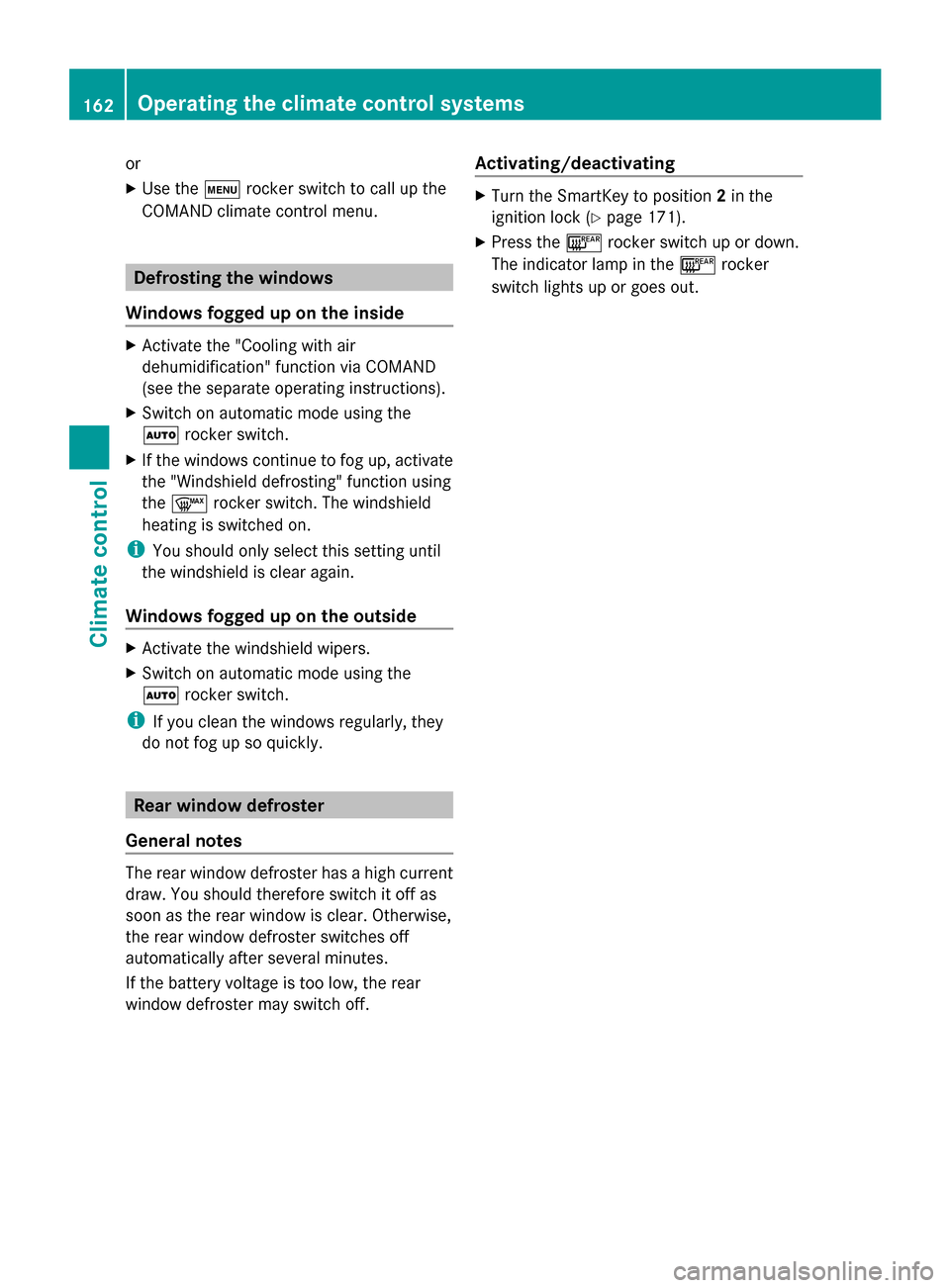
or
X
Use the 008Arocker switch to call up the
COMAND climate control menu. Defrosting the windows
Windows fogged up on the inside X
Activate the "Cooling with air
dehumidification" function via COMAND
(see the separate operating instructions).
X Switch on automatic mode using the
0058 rocker switch.
X If the windows continue to fog up, activate
the "Windshield defrosting" function using
the 0064 rocker switch. The windshield
heating is switched on.
i You should only select this setting until
the windshield is clear again.
Windows fogged up on the outside X
Activate the windshield wipers.
X Switch on automatic mode using the
0058 rocker switch.
i If you clean the windows regularly, they
do not fog up so quickly. Rear window defroster
General notes The rear window defroster has a high current
draw. You should therefore switch it off as
soon as the rear window is clear. Otherwise,
the rear window defroster switches off
automatically after several minutes.
If the battery voltage is too low, the rear
window defroster may switch off. Activating/deactivating X
Turn the SmartKey to position 2in the
ignition lock (Y page 171).
X Press the 006Crocker switch up or down.
The indicator lamp in the 006Crocker
switch lights up or goes out. 162
Operating the climate control systemsClimate control
Page 165 of 434
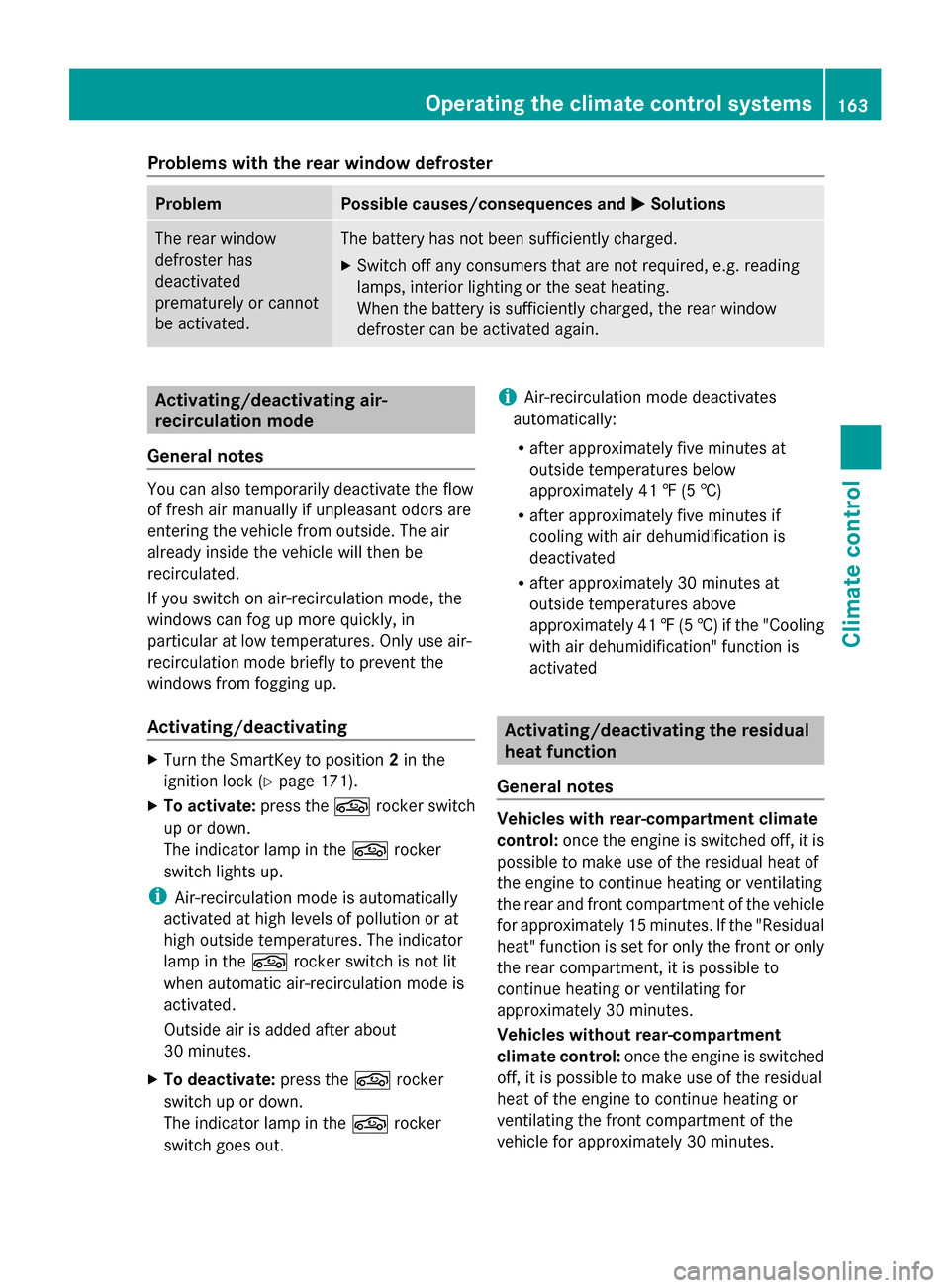
Problems with the rear window defroster
Problem Possible causes/consequences and
0050
0050Solutions The rear window
defroster has
deactivated
prematurely or cannot
be activated. The battery has not been sufficiently charged.
X
Switch off any consumers that are not required, e.g. reading
lamps, interior lighting or the seat heating.
When the battery is sufficiently charged, the rear window
defroster can be activated again. Activating/deactivating air-
recirculation mode
General notes You can also temporarily deactivate the flow
of fresh air manually if unpleasant odors are
entering the vehicle from outside. The air
already inside the vehicle will then be
recirculated.
If you switch on air-recirculation mode, the
windows can fog up more quickly, in
particular at low temperatures. Only use air-
recirculation mode briefly to prevent the
windows from fogging up.
Activating/deactivating X
Turn the SmartKey to position 2in the
ignition lock (Y page 171).
X To activate: press the0072rocker switch
up or down.
The indicator lamp in the 0072rocker
switch lights up.
i Air-recirculation mode is automatically
activated at high levels of pollution or at
high outside temperatures. The indicator
lamp in the 0072rocker switch is not lit
when automatic air-recirculation mode is
activated.
Outside air is added after about
30 minutes.
X To deactivate: press the0072rocker
switch up or down.
The indicator lamp in the 0072rocker
switch goes out. i
Air-recirculation mode deactivates
automatically:
R after approximately five minutes at
outside temperatures below
approximately 41 ‡ (5 †)
R after approximately five minutes if
cooling with air dehumidification is
deactivated
R after approximately 30 minutes at
outside temperatures above
approximately 41 ‡(5 †) if the "Cooling
with air dehumidification" function is
activated Activating/deactivating the residual
heat function
General notes Vehicles with rear-compartment climate
control:
once the engine is switched off, it is
possible to make use of the residual heat of
the engine to continue heating or ventilating
the rear and front compartment of the vehicle
for approximately 15 minutes. If the "Residual
heat" function is set for only the front or only
the rear compartment, it is possible to
continue heating or ventilating for
approximately 30 minutes.
Vehicles without rear-compartment
climate control: once the engine is switched
off, it is possible to make use of the residual
heat of the engine to continue heating or
ventilating the front compartment of the
vehicle for approximately 30 minutes. Operating the climate control systems
163Climate control
Page 166 of 434
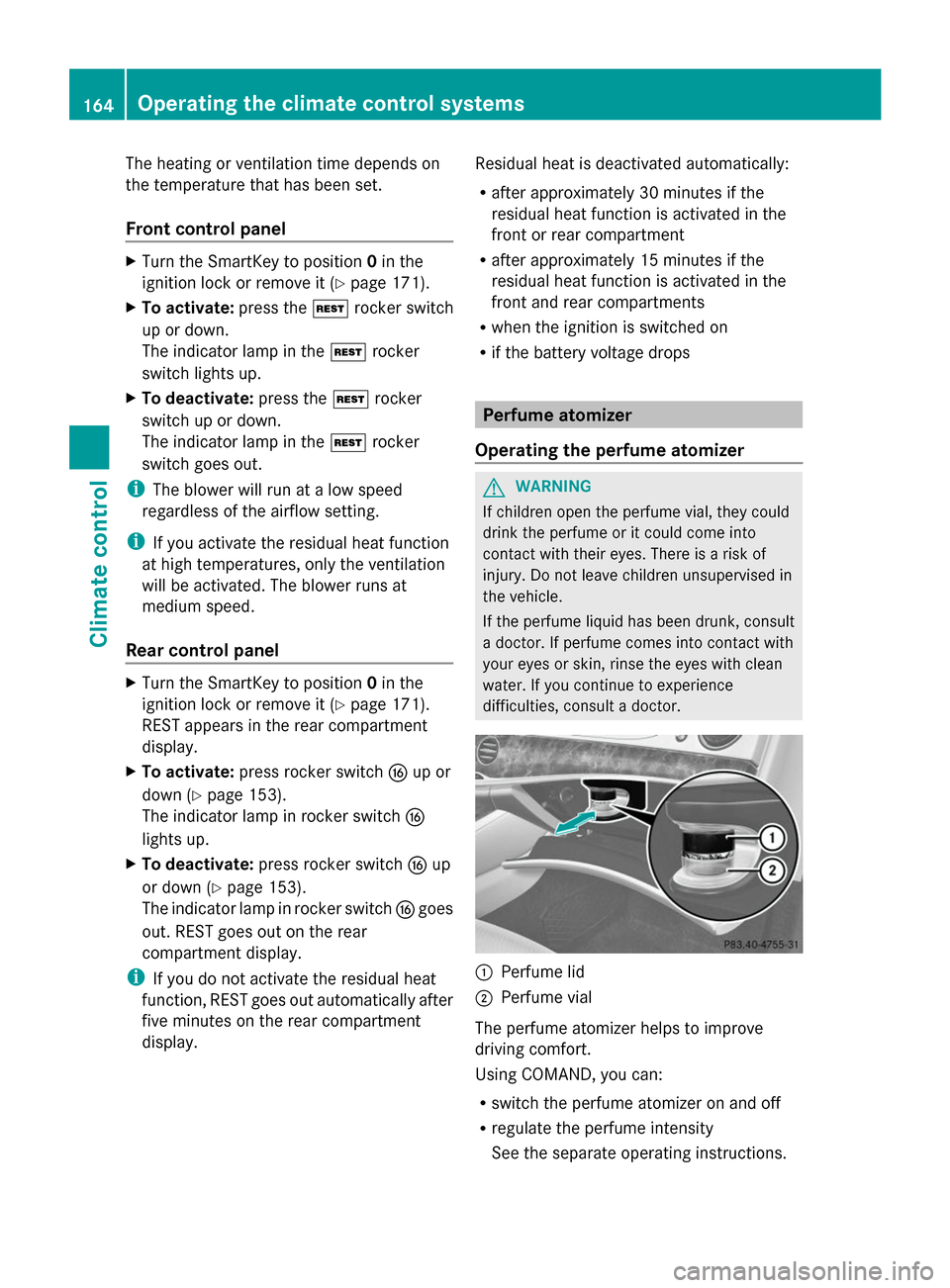
The heating or ventilation time depends on
the temperature that has been set.
Front control panel X
Turn the SmartKey to position 0in the
ignition lock or remove it (Y page 171).
X To activate: press the004Brocker switch
up or down.
The indicator lamp in the 004Brocker
switch lights up.
X To deactivate: press the004Brocker
switch up or down.
The indicator lamp in the 004Brocker
switch goes out.
i The blower will run at a low speed
regardless of the airflow setting.
i If you activate the residual heat function
at high temperatures, only the ventilation
will be activated. The blower runs at
medium speed.
Rear control panel X
Turn the SmartKey to position 0in the
ignition lock or remove it (Y page 171).
REST appears in the rear compartment
display.
X To activate: press rocker switch 0074up or
down (Y page 153).
The indicator lamp in rocker switch 0074
lights up.
X To deactivate: press rocker switch 0074up
or down (Y page 153).
The indicator lamp in rocker switch 0074goes
out. REST goes out on the rear
compartment display.
i If you do not activate the residual heat
function, REST goes out automatically after
five minutes on the rear compartment
display. Residual heat is deactivated automatically:
R
after approximately 30 minutes if the
residual heat function is activated in the
front or rear compartment
R after approximately 15 minutes if the
residual heat function is activated in the
front and rear compartments
R when the ignition is switched on
R if the battery voltage drops Perfume atomizer
Operating the perfume atomizer G
WARNING
If children open the perfume vial, they could
drink the perfume or it could come into
contact with their eyes. There is a risk of
injury. Do not leave children unsupervised in
the vehicle.
If the perfume liquid has been drunk, consult
a doctor. If perfume comes into contact with
your eyes or skin, rinse the eyes with clean
water. If you continue to experience
difficulties, consult a doctor. 0043
Perfume lid
0044 Perfume vial
The perfume atomizer helps to improve
driving comfort.
Using COMAND, you can:
R switch the perfume atomizer on and off
R regulate the perfume intensity
See the separate operating instructions. 164
Operating the climate control systemsClimate control
Page 167 of 434
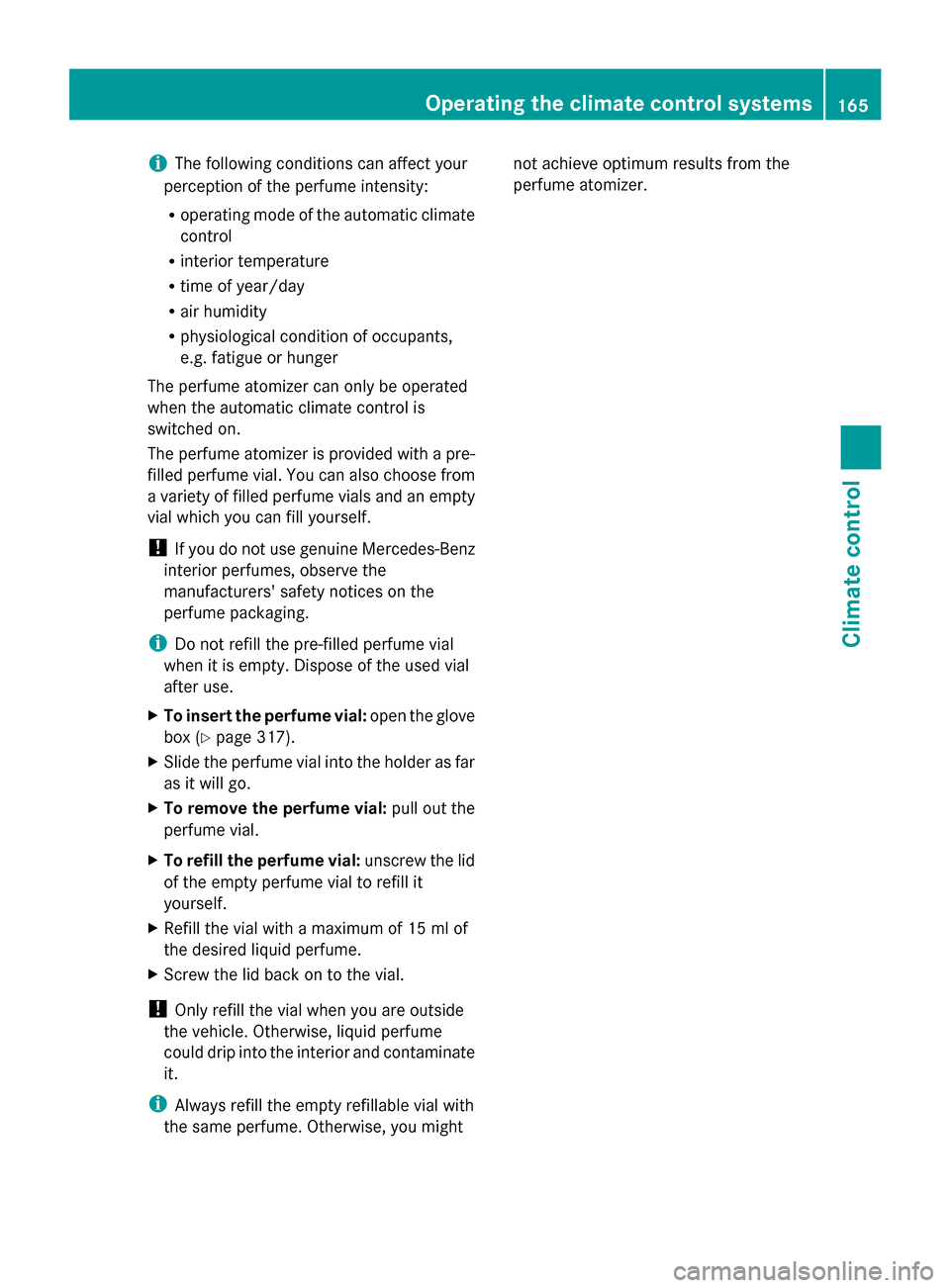
i
The following conditions can affect your
perception of the perfume intensity:
R operating mode of the automatic climate
control
R interior temperature
R time of year/day
R air humidity
R physiological condition of occupants,
e.g. fatigue or hunger
The perfume atomizer can only be operated
when the automatic climate control is
switched on.
The perfume atomizer is provided with a pre-
filled perfume vial. You can also choose from
a variety of filled perfume vials and an empty
vial which you can fill yourself.
! If you do not use genuine Mercedes-Benz
interior perfumes, observe the
manufacturers' safety notices on the
perfume packaging.
i Do not refill the pre-filled perfume vial
when it is empty. Dispose of the used vial
after use.
X To insert the perfume vial: open the glove
box (Y page 317).
X Slide the perfume vial into the holder as far
as it will go.
X To remove the perfume vial: pull out the
perfume vial.
X To refill the perfume vial: unscrew the lid
of the empty perfume vial to refill it
yourself.
X Refill the vial with a maximum of 15 ml of
the desired liquid perfume.
X Screw the lid back on to the vial.
! Only refill the vial when you are outside
the vehicle. Otherwise, liquid perfume
could drip into the interior and contaminate
it.
i Always refill the empty refillable vial with
the same perfume. Otherwise, you might not achieve optimum results from the
perfume atomizer. Operating the climate control systems
165Climate control Z
Page 168 of 434
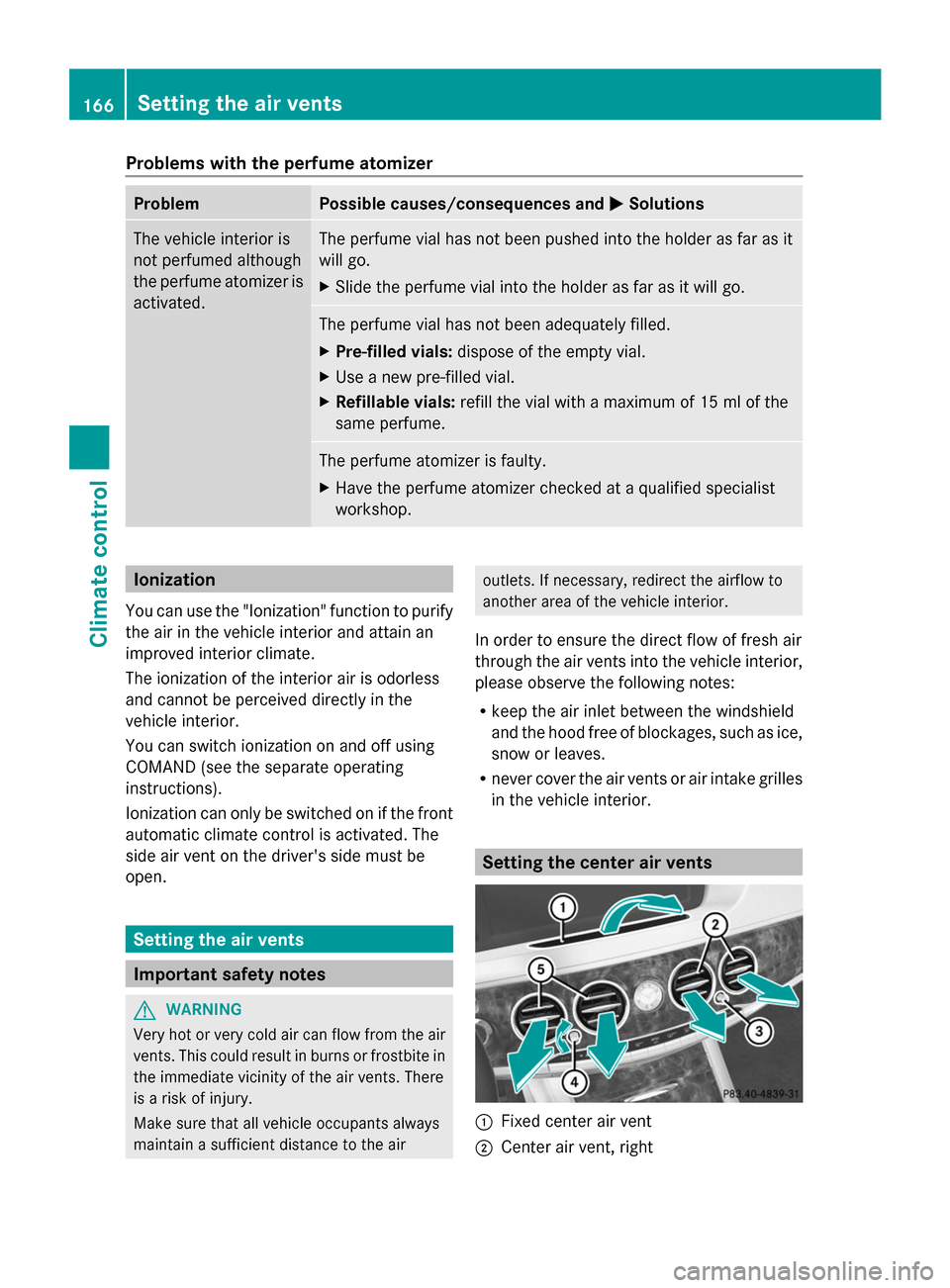
Problems with the perfume atomizer
Problem Possible causes/consequences and
0050
0050Solutions The vehicle interior is
not perfumed although
the perfume atomizer is
activated. The perfume vial has not been pushed into the holder as far as it
will go.
X Slide the perfume vial into the holder as far as it will go. The perfume vial has not been adequately filled.
X Pre-filled vials: dispose of the empty vial.
X Use a new pre-filled vial.
X Refillable vials: refill the vial with a maximum of 15 ml of the
same perfume. The perfume atomizer is faulty.
X
Have the perfume atomizer checked at a qualified specialist
workshop. Ionization
You can use the "Ionization" function to purify
the air in the vehicle interior and attain an
improved interior climate.
The ionization of the interior air is odorless
and cannot be perceived directly in the
vehicle interior.
You can switch ionization on and off using
COMAND (see the separate operating
instructions).
Ionization can only be switched on if the front
automatic climate control is activated. The
side air vent on the driver's side must be
open. Setting the air vents
Important safety notes
G
WARNING
Very hot or very cold air can flow from the air
vents. This could result in burns or frostbite in
the immediate vicinity of the air vents. There
is a risk of injury.
Make sure that all vehicle occupants always
maintain a sufficient distance to the air outlets. If necessary, redirect the airflow to
another area of the vehicle interior.
In order to ensure the direct flow of fresh air
through the air vents into the vehicle interior,
please observe the following notes:
R keep the air inlet between the windshield
and the hood free of blockages, such as ice,
snow or leaves.
R never cover the air vents or air intake grilles
in the vehicle interior. Setting the center air vents
0043
Fixed center air vent
0044 Center air vent, right 166
Setting the air ventsClimate control
Page 169 of 434

0087
Center vent thumbwheel, right
0085 Center vent thumbwheel, left
0083 Center air vent, left
X To open/close: press thumbwheel 0087
or 0085.
The thumbwheel pops out.
X Turn thumbwheel 0087or0085 clockwise or
counter-clockwise.
X To adjust the air direction: hold rear air
vent 0044or0083 by the middle fin and move
up or down or to the left or right. Setting the side air vents
0043
Side window defroster vent
0044 Side air vent
0087 Thumbwheel for left side air vent
X To open/close: press thumbwheel 0087.
The thumbwheel pops out.
X Turn thumbwheel 0087clockwise or counter-
clockwise.
X To adjust the air direction: hold side air
vent 0044by the middle fin and move it up or
down or to the left or right. Setting the glove box air vent
! Close the air vent when heating the
vehicle.
At high outside temperatures, open the air
vent and activate the "cooling with air
dehumidification" function. Otherwise, temperature-sensitive items stored in the
glove box could be damaged.
When automatic climate control is activated,
the glove box can be ventilated, for instance
to cool its contents. The level of airflow
depends on the airflow and air distribution
settings. 0043
Air vent thumbwheel
0044 Air vent
X To open/close: turn thumbwheel 0043
clockwise or counter-clockwise. Setting the rear-compartment air
vents
Setting the center vents in the rear
compartment 0043
Rear-compartment air vent, left
0044 Rear-compartment air vent, right
0087 Rear-compartment air vent thumbwheel,
right Setting the air vents
167Climate control Z
Page 172 of 434

Useful information
i This Operator's Manual describes all
models and all standard and optional
equipment of your vehicle available at the
time of publication of the Operator's
Manual. Country-specific differences are
possible. Please note that your vehicle may
not be equipped with all features
described. This also applies to safety-
related systems and functions.
i Read the information on qualified
specialist workshops: (Y page 27).Notes on breaking-in a new vehicle
Important safety notes
The sensors of certain drive and driving safety
systems automatically reset during driving for
a certain distance after the vehicle has been
delivered or after repairs have been carried
out. Complete system effectiveness is
reached only after completion of this teach-
in procedure.
New and replaced brake pads and discs only
reach their optimum braking effect after
several hundred kilometers of driving.
Compensate for this by applying greater force
to the brake pedal. The first 1000 miles(1500 km)
The more you look after the engine when it is
new, the more satisfied you will be with its
performance in the future.
R You should therefore drive at varying
vehicle and engine speeds for the first
1000 miles (1500 km).
R Avoid heavy loads, e.g. driving at full
throttle, during this period.
R When shifting gears manually, upshift in
good time, before the tachometer needle
reaches 00C3of the way to the red area of the
tachometer. R
Do not manually shift to a lower gear to
brake the vehicle.
R Try to avoid depressing the accelerator
pedal beyond the point of resistance
(kickdown).
R All vehicles (except AMG vehicles):
ideally, for the first 1,000 miles (1,500 km),
drive in program E.
After 1000 miles (1500 km), you can increase
the engine speed gradually and accelerate
the vehicle to full speed.
Additional breaking-in notes for AMG
vehicles:
R Do not drive faster than 85 mph
(140 km/h) for the first 1,000 miles
(1,500 km).
R Only allow the engine to reach a maximum
engine speed of 4,500 rpm briefly.
R Change gear in good time.
R Ideally, for the first 1,000 miles (1,500 km),
drive in program C.
You should also observe these notes on
breaking in if the engine or parts of the drive
train on your vehicle have been replaced.
Always observe the respective speed limits. Driving
Important safety notes
G
WARNING
Objects in the driver's footwell can restrict the
pedal travel or obstruct a depressed pedal.
The operating and road safety of the vehicle
is jeopardized. There is a risk of an accident.
Make sure that all objects in the vehicle are
stowed correctly, and that they cannot enter
the driver's footwell. Install the floormats
securely and as specified in order to ensure
sufficient clearance for the pedals. Do not use
loose floormats and do not place floormats on
top of one another. 170
DrivingDriving and parking